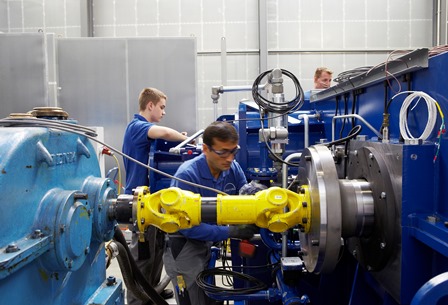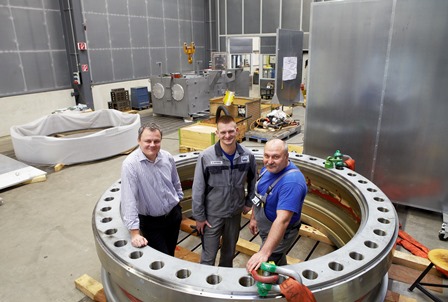
At Clemson University, South Carolina, USA, an old shipyard has been turned into the world’s largest wind energy testing centre. Renk Test System (RTS), a German company, has provided a facility containing the world’s most powerful wind turbine tests rigs, which permit simulation of any type of wind force.

As wind energy rapidly develops worldwide, the US government plans to expand the country’s production from 35 gigawatts to over 300 gigawatts, equivalent to 270 medium sized nuclear power plants. The new testing centre plays a crucial role in achieving this goal. For the first time, it will test wind turbine prototypes of up to 15 megawatts (MW) with every type of wind force, including hurricanes. The fact that today’s average wind turbines generate 3MW – 7MW, indicates the power of the testing facility.
“You don’t need to wait for the storm of the century,” says Jens Schneider, project manager at RTS in Augsburg, Germany. “The rigs simulate the most extreme conditions in a matter of months and manufacturers save hundreds of millions of dollars by detecting weak points before deploying new systems. The savings in time and money are one reason why interest in our testing systems has skyrocketed recently.”
RTS was commissioned to build two test stands when the Clemson project started a couple of years ago. The company, a subsidiary of RENK AG, has developed and manufactured high-end testing facilities for gears, drive components and complete vehicles since the 1960s.

The Clemson project is the largest single contract in the company’s history so far and RTS added personnel to its Mooresville and Augsburg offices to meet the requirements. It designed two test rigs: A 15MW stand with a fully dynamic load application that uses hydraulic cylinders and an 11,000 horsepower motor to impart force and moments onto the turbine’s rotating shaft; as well as a smaller stand for test objects up to 7.5MW.TS was commissioned to build two test stands when the Clemson project started a couple of years ago. The company, a subsidiary of RENK AG, has developed and manufactured high-end testing facilities for gears, drive components and complete vehicles since the 1960s.
The 15MW rig is 30m (98.5 feet) long, 13m (42.5 feet) wide and 14m (46 feet) high. Ever since wind energy took off in the 1980s, tests have been limited to components, but these huge test rigs allow a complete wind turbine nacelle with an average weight of 300 tonnes to 400 tonnes to be attached to the test bed, simulating dynamic loads in six axes of freedom. RTS shipped 800 tonnes of components to the US, including Superbolt multi-jackbolt tensioners (MJTs) and expansion bolts from Nord-Lock.
“This is state of the art technology that will be used to test new wind turbines over the next 30 years,” mentions Jens Schneider. “That’s why we needed bolting security that is able to cope with tomorrow’s more powerful wind turbines, as well as today’s.”
874 Superbolt MJTs and expansion bolts, varying in size from M42 to M125, secure the most critical bolted joints of both test rigs. The largest ones fix the test rig’s single units to the 6,000 tonnes concrete foundations. These ensure the test beds are detached from the main structure, preventing vibrations from reaching it and impacting the test results. The rest are fitted to the test bed gears controlling the speed of the test object, as well as in the load unit’s shaft connection, which simulates the wind.
“These parts must handle extreme dynamic loads, replicating the harshest offshore conditions, and huge bolts are needed to keep everything in place,” Jens Schneider explains. “Conventional bolts require heavy hydraulic wrenches for tightening and removal. Superbolt products from Nord-Lock provide the same or elevated preload levels, but allow us to work with normal hand tools, which are much more flexible.”
“90% of the rig’s components were manufactured in Augsburg, but there wasn’t space to pre-build and test the whole facility here,” explains Jens Schneider. “We only had one shot to get it right and using Superbolt tensioners made it possible for us to install both rigs within just six months.”


Having spent a decade in the fastener industry experiencing every facet – from steel mills, fastener manufacturers, wholesalers, distributors, as well as machinery builders and plating + coating companies, Claire has developed an in-depth knowledge of all things fasteners.
Alongside visiting numerous companies, exhibitions and conferences around the world, Claire has also interviewed high profile figures – focusing on key topics impacting the sector and making sure readers stay up to date with the latest developments within the industry.





